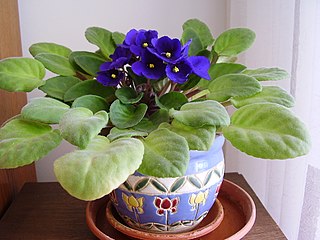
Gesneriaceae, the gesneriad family, is a family of flowering plants consisting of about 152 genera and ca. 3,540 species in the tropics and subtropics of the Old World and the New World, with a very small number extending to temperate areas. Many species have colorful and showy flowers and are cultivated as ornamental plants.

Columnea is a genus of around 200 species of epiphytic herbs and shrubs in the family Gesneriaceae, native to the tropics of the Americas and the Caribbean. The tubular or oddly shaped flowers are usually large and brightly colored – usually red, yellow, or orange – sometimes resembling a fish in shape. A common name is flying goldfish plants due to the unusual flower shape.

Calceolaria, also called lady's purse, slipper flower and pocketbook flower, or slipperwort, is a genus of plants in the family Calceolariaceae, sometimes classified in Scrophulariaceae by some authors. This genus consists of about 388 species of shrubs, lianas and herbs, and the geographical range extends from Patagonia to central Mexico, with its distribution centre in Andean region. Calceolaria species have usually yellow or orange flowers, which can have red or purple spots. The Calceolaria Herbeohybrida group, also called C. herbeohybrida Voss, is a group of ornamental hybrids known only in cultivation, called florists' slipperwort.

Achimenes is a genus of about 25 species of tropical and subtropical rhizomatous perennial herbs in the flowering plant family Gesneriaceae. They have a multitude of common names such as magic flowers, widow's tears, Cupid's bower, or hot water plant.
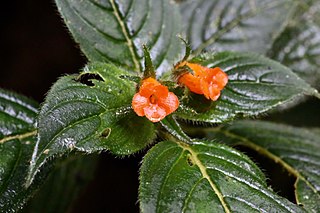
Besleria is a genus of large herbs and soft-stemmed subshrubs or shrubs in the flowering plant family Gesneriaceae. It includes 176 species native to tropical southern Mexico, Central America, South America, and the West Indies.

Sinningia is a genus of flowering plants in the family Gesneriaceae. It is named after Wilhelm Sinning (1792–1874), a gardener of the Botanische Gärten der Friedrich-Wilhelms-Universität Bonn. There are about 65 species of tuberous herbaceous perennials, all occurring in Central and South America, with the greatest concentration of species occurring in southern Brazil.

Parkia is a genus of flowering plants in the family Fabaceae. It belongs to the mimosoid clade of the subfamily Caesalpinioideae. Several species are known as African locust bean.

Swartzia is a genus of flowering plants in the family Fabaceae. It was named in honor of Swedish botanist Olof Swartz and contains about 200 species. Swartzia is restricted in its geographical distribution to the New World Tropics, where it occurs primarily in lowland rainforests, but also in savannas, pre-montane forests, and tropical dry forests. While it can be found throughout the wet lowlands from Mexico and the Caribbean islands to southern Brazil and Bolivia, Swartzia is most abundant and species-rich in Amazonia, where 10–20 species may co-occur at a single site. The species of Swartzia are mostly trees, ranging from small understory treelets to large canopy emergents. Some species, especially in savannas, are mult-stemmed shrubs.

Zygia is a genus of flowering plants in the family Fabaceae. It includes 60 species of tres and shrubs native to the tropical Americas, from Southern Mexico and Cuba to northern Argentina. Typical habitats are tropical forest and coastal zones, generally below 900 meters elevation with a few species extending up to 2800 meters. It belongs to the mimosoid clade of the subfamily Caesalpinioideae.

Munnozia is a genus of flowering plants in the family Asteraceae. It is centered in the Andes.
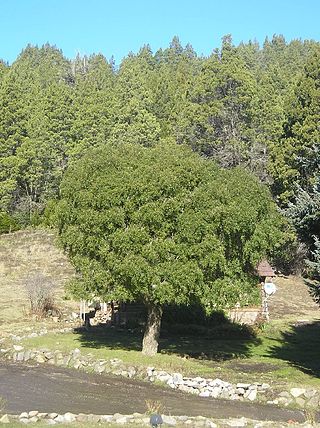
Maytenus is a genus of flowering plants in the family Celastraceae. Members of the genus are distributed throughout Central and South America, Southeast Asia, Micronesia, and Australasia, the Indian Ocean and Africa. They grow in a very wide variety of climates, from tropical to subpolar. The traditional circumscription of Maytenus was paraphyletic, so many species have been transferred to Denhamia and Gymnosporia.
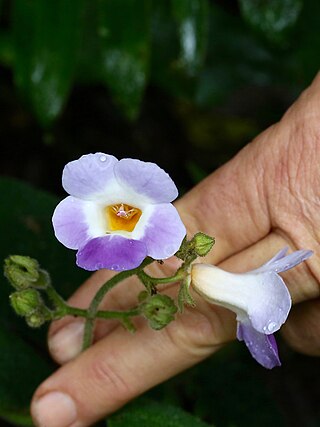
Monopyle is a genus of plants in the family Gesneriaceae.
Napeanthus is a genus of plant in family Gesneriaceae. It includes 17 species of terrestrial, perennial herbs with rhizomes native to the tropical Americas, ranging from Mexico to Bolivia and southern Brazil.

Nautilocalyx is a genus of plants in the family Gesneriaceae. Its native range stretches from Costa Rica to southern Tropical America and to Trinidad. It is also found in Bolivia, Brazil, Colombia, Costa Rica, Ecuador, French Guiana, Guyana, Panamá, Peru, Suriname, Trinidad-Tobago and Venezuela.
Phinaea is a genus of flowering plants in family Gesneriaceae. It contains three species native to the Americas, including western and central Mexico, Cuba and Haiti, and Colombia and northern Brazil.

Tournefortia, often called soldierbushes, is a genus of flowering plants in the borage family, Boraginaceae.
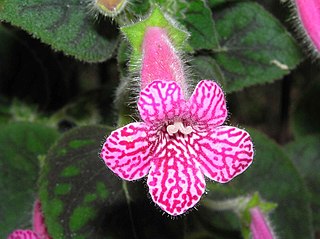
Kohleria amabilis, the tree gloxinia, is a species of the flowering plant belonging to the family Gesneriaceae.

Coussarea is a genus of flowering plants in the family Rubiaceae. The genus is found from southern Mexico to tropical America.
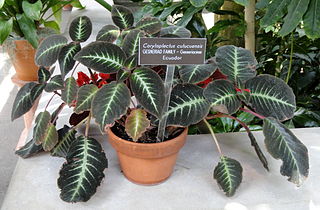
Corytoplectus is a genus in the plant family Gesneriaceae. Plants from Corytoplectus are found in Bolivia, Brazil North, Colombia, Ecuador, Guyana, southwestern Mexico, Peru, Venezuela, in the cloud-forests of the high cordillera. The genus contains c. 12 species. The genus differs from the closely related Alloplectus in having an erect umbellate inflorescence and berries. The type species is C. capitatus.

Drymonia is a genus of flowering plants in the family Gesneriaceae. It includes 82 species native to the tropical Americas, ranging from southern Mexico through Central America and northern South America to Bolivia and southeastern Brazil.


















